Introductory guide to sweet wines
An abundance of wines… sweet and semi-sweet, Raisin and Straw wines, Ice wines, Tokaji, Vin Santo and Passito wines, sweet sherries, Rancio wines… the vocabulary used to define sweet wines is hugely prolific. Are they all made in the same way? How many different types of sweet wine are there? Here is an introductory guide to the fascinating world of sweet wines, imbued with character, steeped in history and tradition, delicious drops of pure pleasure.

What is sweet wine?
We define sweet wine as containing an amount of residual sugar above 45 grams per litre. This doesn’t mean that sugar has been added to the wine, but that some of the sugars which the grapes naturally contain haven’t been fermented. Why not? Due to saturation, because the fruit holds so much sugar that it ends up stopping the action of the yeasts, or the process is halted by means of adding wine alcohol or else by reducing the temperature. Sweet wines boast a long history and each distinct culture has employed its own methods, taking into account the climatic conditions and any local traditions.
How are sweet wines produced?
Although there are numerous styles of sweet wine, we can start by dividing them into two groups, depending on how their sweetness and alcoholic strength have been obtained. Therefore, we categorise them as natural sweet wines and naturally sweet wines.
The natural sweet wines are those whose fermentation has been halted by the addition of wine alcohol, thus leaving an amount of residual sugar. Their alcohol content is a combination of the added alcohol and what is acquired during fermentation.
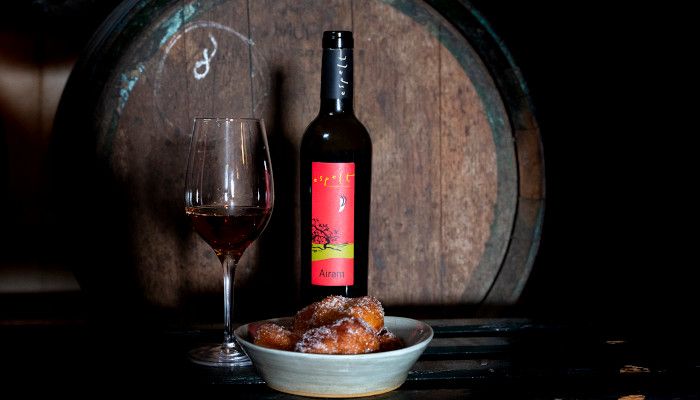
Airam is a natural sweet wine. Fermentation is halted by adding alcohol in order to maintain around 90 gr/l of residual sugar. Photograph by courtesy of Ernest Abentín / Espelt Viticultors de l'Empordà.
Some naturally sweet wines are late harvest, produced without the addition of alcohol, simply by means of fermenting the must of exceptionally ripe grapes. The high concentration of sugars in the berries ends up by absorbing the activity of the yeasts, which stop performing, thus leaving a considerable amount of residual sugar in the wine.

Red Garnacha grapes before undergoing the production process of Rasim Vimadur Negre, a sweet late harvest wine. Bunches over-ripen on the actual vine and they’re subsequently left to dehydrate a little more in small crates. Photograph by courtesy of Cooperativa L'Olivera.
Deserving a special mention are Mistela, aromatised sweet wines and fortified sweet wines of the Cream sherry type, where all of them result from blending a sweet wine or must with other wine-based or natural products.
Mistela is a liqueur which is obtained by mixing non-fermented must with wine alcohol. It’s extremely sweet, since all the natural grape sugar remains in place.
The most traditional aromatised sweet wines are Orange Wine from the Condado de Huelva in Andalucía, and Barolo Chinato from the Langhe region in the Piedmont. Huelva’s Orange Wine starts off with a sweet white wine, to which wine alcohol macerated with orange peel is added; Barolo Chinato also has wine alcohol with a maceration of herbs added to it, but in this case sugar as well. By the way, Orange Wine from Huelva, a sweet wine, shouldn’t be confused with certain white wines macerated with grape skins and known in Spanish as ‘vinos naranja’ or Orange wines, due to the colour they acquire, yet with no connection at all to the aroma or taste of oranges.
Traditional Andalucian sherries are obtained by blending a fortified type of wine such as a Fino, Amontillado or Oloroso with a Pedro Ximénez sweet wine: these sherries are known as Pale Cream, Medium and Cream.
Which are the main types of sweet wine?
The two categories are either natural sweet wines or naturally sweet wines (with the exception of Mistela). However, even though they are always based on one of two methods, the diversity of production techniques and the particular circumstances of each individual climate, culture and tradition make it difficult at times to establish exactly which category a wine belongs to, because in many cases the production methods are practically the same. Therefore, we could say that a sweet PX is a Raisin wine, but it’s also a natural sweet wine, that an Ice wine is also a late harvest wine, and there’s no doubt that many Muscatels and Garnachas which have had wine alcohol added and are matured by means of the solera system could be classified as both natural sweet wines and also Rancios. A lot depends on the specific emphasis and on the particular tradition. It’s an extremely complex scenario, nevertheless we’d like to highlight the following important groups.
Noble Rot wines
Noble Rot or botrytised wines are named after the fungal disease which causes such a significant reaction, Botrytis cinerea. This micro-organism dries out the berries by absorbing the water inside them and concentrating the sugars and acidity in a totally natural way. This process requires some very specific weather conditions: humid nights and windy sunny days which dry the grapes. This is the only way the fungus will have a positive effect and enable grapes to be picked which, despite an unappealing appearance with a cottony bloom, will be transformed into a liquid with incredibly seductive aromas that tastes absolutely wonderful. Honey, smoke, orange peel, beeswax and incense are just some of the scents concealed inside the finest bottles of Tokaji, Sauternes, Trockenbeerenauslese (TBA) and Sélection de Grains Nobles (SGN). Beerenauslese (BA) wines are also produced using botrytised grapes, although only partially so.
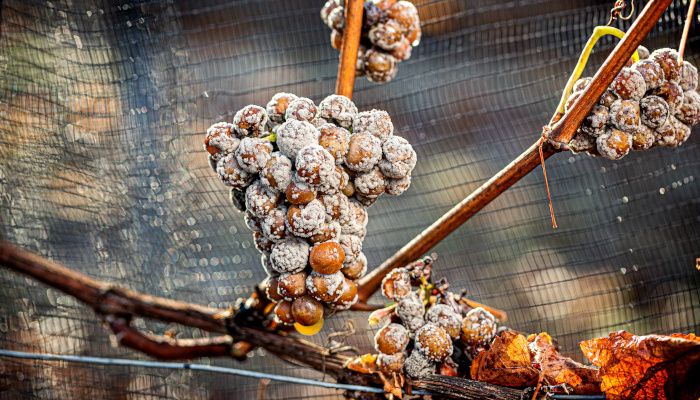
Grapes affected by the fungal disease Botrytis cinerea in an Austrian vineyard.
Rancio wines
Rancios are wines obtained by oxidation, which means the wine undergoes a controlled exposure to oxygen. This is achieved successfully in barrels that are not completely full or else in glass demi-johns exposed to the elements. They are mainly made from varieties which favour being oxidised, such as the Garnacha, and using wines with a high level of alcoholic strength (16-18%), in order to avoid the risk of them turning into vinegar. They taste pungent, tart and saline, while on the nose dried fruits, varnish, spices, tobacco and cocoa can be identified. Fondillón from Alicante, certain wines from Banyuls in France and the Rancios produced in Catalonia (Priorat, Tarragona, Empordà) are among the most highly regarded Rancio wines.
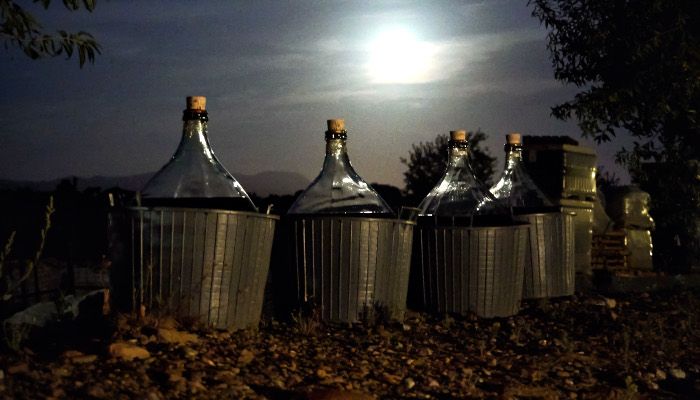
In Catalonia, the act of leaving bunches of grapes or wines exposed to the elements by day and night is called 'a sol i serena' (out in the sun and calm). The photo shows glass demi-johns during the oxidation process of some of the Garnacha that will produce the wine Sols, made by the La Vinyeta winery. The demi-johns are not emptied completely, therefore it resembles the solera system used for making sherry. Photograph by courtesy of La Vinyeta.
Raisin wines
Raisin wines are made using grapes which, once picked, have been allowed to dry in order to concentrate the sugars. This can be done by two different methods: placing bunches on drying mats or hanging them up, from the roof of a barn. The musts obtained after these processes are highly concentrated and give rise to boundless aromas of honey and crystallised fruit, of herbal sweets and quince. Straw wines from the Jura, Passitos from Pantelleria, Reciotos from Valpolicella, Pedro Ximénez sweet sherry, Malaga’s Muscatels and Tuscany’s Vin Santo are some of the most well-known Raisin wines.
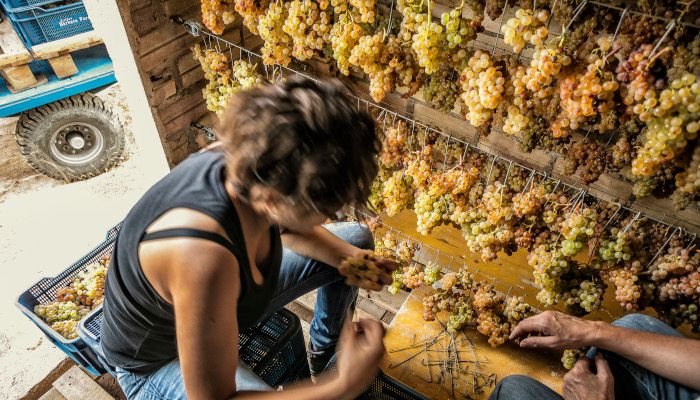
Drying Garnacha Blanca grapes for the production of the wine Dolç Bàrbara Forés. Photograph by courtesy of Rafael López Monné / Celler Bàrbara Forés.

During the drying out process, the fruit must not be in contact with the ground, to prevent it from rotting. Using a network of straw matting or creating long passages of mats is a sight very often seen in Andalucía.
Ice wine
Ice wine is exclusively produced in cold climate regions where bunches can be left hanging on the vines during the first weeks of winter and harvested at a temperature ranging between 7 and 12 ºC below zero. In these conditions, the watery part of the berries (85%) is frozen, which means that after pressing, a very small amount of must is acquired but it’s also very concentrated and rich in extract. The most famous Ice wines are to be found in Germany (Eiswein), Austria and Canada (Ice-wine).
Semi-sweet and semi-dry wines
Semi-sweet wines don’t strictly speaking come under the sweet category, as their name suggests: they contain between 12 and 45 grams/litre of residual sugar. They’re produced using grapes which have been picked a little later than would be usual for the production of a dry wine, but without fully becoming a late harvest wine.
The best-known semi-sweet wines originate in Italy: these are the Moscatos d’Asti, along with sweet Lambruscos, Brachettos d'Acqui and Sangue di Giuda, with all of them retaining some carbonic and so, in effect, semi-sparkling sweet wines. Some aromatic whites in the Trentino and Orvieto regions also offer a degree of sweetness, and this applies to some reds made using the Bonarda variety in Oltrepò Pavese and from Gutturnio grapes in Emilia, as well as the occasional red Lambrusco; these are semi-dry wines, known in Italy as amabile.
Germany can also look to a great tradition regarding the production of semi-sweet and semi-dry wines. A considerable number of wines labelled as Kabinett and Feinherb come under the sweet umbrella. Among semi-sweet and sweet, are wines falling within the Auslese category, halfway between the late harvest (Spätlese, in German) and the Beerenauslese, made from a selection of grapes not yet affected by noble rot, Botrytis cirenea.
Other sweet wines
There are other less popular types of sweet wine, such as sparkling sweet wines and dessert Cavas (with the addition of 50+ gr. sugar/litre) or ‘cooked’ wines, where the must has been boiled, just as the Romans used to do with their defrutum.
The most famous sweet wine producing regions in the world
Tokaj-Hegyalja in Hungary and Sauternes in Bordeaux are the two great regions of reference when aiming to find intense sweet Noble Rot white wines; also found in the Coteaux du Layon appellation in the Loire Valley.
Canada and Austria produce some of the best Ice wines using grapes frozen due to the harsh winters, which is exactly what happens in Germany, a country that produces memorable naturally sweet wines from botrytised grapes of the Riesling variety: the wonderful Beerenauslese and Trockenbeerenauslese.
Italy makes some splendid sweet wines from dried grapes, such as Vin Santo, Recioto and Passito, whereas Spain is the ideal place to come across natural sweet wines, like the Garnachas produced in the Empordà in Catalonia, and the delightful Pedro Ximénez sweet sherries from Andalucía, Rancios and delicious Raisin wines to be found in Malaga’s Axarquía and all the way along the Mediterranean coast.
The most prevalent varieties
The majority of sweet wines are produced from white grapes, even though the wine’s dark colour might cause us to doubt this at times: Pedro Ximénez, for example, is a white variety and one of the most predominately used, and so too are the various Muscatels (Moscato Bianco, Muscat of Alexandria and Muscat à Petits Grains), Malvasias and Garnachas (known as ‘Lledoner’ in the Empordà), Riesling and Gewürztraminer, Sémillon, Garganega and the various types of Trebbiano.
Sweet wines are also made from red varieties, such as Vin Santo using Sangiovese, sweet Monastrell wines which are products of Alicante and Jumilla —or of Alella, where it’s known locally by the name Mataró—, sweet Garnacha wines emanating from the Catalan denominations, Reciotos with a combination of Corvina, Corvinone, Rondinella and Molinara and those sweet semi-sweet Frizzante wines employing predominantly Brachetto red grapes in the Piedmont.
The choice of one particular variety or another corresponds to the requirements and characteristics of each type of wine, and to the individual varieties and their ability to adapt to the local climate. Generally speaking, they tend to be varieties with a high level of acidity, essential for counteracting the wine’s sweetness, but other aspects have to be considered. In the production of Noble Rot wines, the varieties which are more prone to the effect of Botrytis cirenea are understandably predominant: Furmint in Hungary (also Hárslevelü, with less acidity), Sémillon in France and Riesling in Austria and Germany. For wines requiring aroma or a high sugar content for conversion into raisins, the sweeter and more aromatic varieties are chosen: the various Muscatels (Zibibbo in Sicily), Malvasías and Lambruscos, Pedro Ximénez and the Gewürztraminer. Other grapes are selected for their propensity for oxidation, and this is the case for Garnachas used in the production of Rancios and natural sweet wines destined for ageing, or because they adapt well to the cold, as occurs with the white varieties Vidal and Riesling or the red Cabernet Franc.
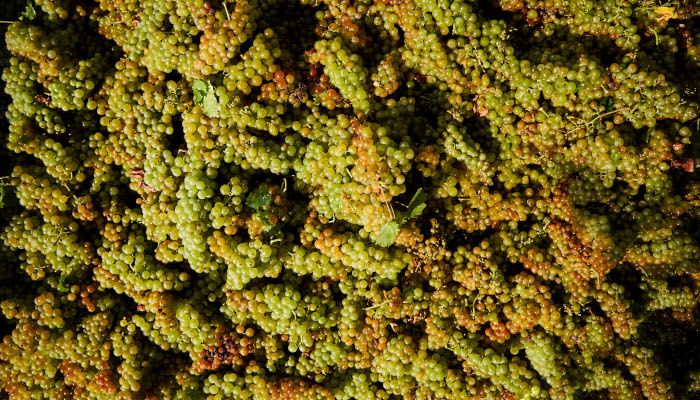
Garnacha Blanca grapes harvested with an element of over-ripeness so as to achieve the typical aromas of raisins, dried apricots, figs and marmalade found in sweet Garnacha wines from the Empordà. Photograph by courtesy of La Vinyeta.

Pairing up sweet wines
Sweet wines are usually considered to be dessert wines, but they can be served right the way through a meal, starting as an aperitif and ending as a replacement for a coffee or glass of liqueur. They also prove a very good choice on their own at the end of the day, for a little treat of pure pleasure.
When choosing a sweet wine, we can look for both similarities and contrasts with the accompanying dessert or dish. For example, a late harvest Riesling or semi-sweet wine has the moderate amount of sweetness that is ideal for serving with an apple tart; the caramel notes of a Sauternes or a Raisin wine combine well with a custard dessert, and the toasty nuances of a Rancio or a mature sweet sherry wine match up perfectly with pastries, biscuits, and almond or pecan tarts. We can pair up Noble Rot wines on the whole with blue and washed-rind cheeses like Stilton and Gruyere, or else with any dish containing mushrooms: they all have fungal-based aromas.
The balance created by a sweet-savoury contrast is the objective when pairing up strong and intensely-flavoured cheeses with sweet wines. What sort of cheese and what type of sweet wine? When selecting, there are other factors to take into account, such as body, texture, intensity and levels of sweetness and acidity. The more highly seasoned or flavoursome the dish, the more intense and acidic the sweet wine can and should be; the lighter or more delicately flavoured the dish, the lighter and more delicate should be the accompanying wine. The wine always ought to be a bit sweeter than the actual food.
Therefore, we can pair up rich pâté and foie gras or a fruit flan with a refined Tokaji, shell fish and seafood with a delicious Ice wine, and tempura-battered courgette flowers, tiramisu, soft cheeses, fruit salads and mousses with a semi-sparkling sweet wine or a semi-sweet wine; whereas for accompanying savoury pasta dishes, fruit cakes, brownies, chocolate flans, coconut or pecan tarts, cupcakes, muffins, and fritters, we’d choose an intense Raisin wine, a natural sweet wine or a Rancio. Always trying not to overdo the total amount of sweetness: with a Pedro Ximénez sweet sherry, one of the best combinations is to drizzle it over vanilla ice cream, sometimes with pineapple, or just on its own with ice and a slice of orange.
Sweet wines are well able to accompany meat and fish stews, casseroles and roasts, offering a host of possibilities. Apart from the intensity or delicacy of the dish, we should consider its ingredients and any sauce used in the recipe. For example, duck with orange sauce or salmon in puff pastry pair up perfectly with a fragrant Muscatel due to its citric aromas and fat-reducing acidity, whereas cooked and cured meats will match up better with a lighter, semi-sparkling sweet wine.
The smoky flavour of grilled or barbecued meats, fish and vegetables works wonders with the sweetness and fruitiness of a young red wine, including any variety of Raisin wine or an Italian Passito.
When it comes to raw fish and salads, lighter dishes, it’s better to pick a semi-sweet wine, and with greater acidity, the more acidic or citrussy the dish should be.
For fish and meats accompanied by sweet and sour sauces, reductions and vinaigrettes, a natural sweet wine or Vin Doux Naturel might even be a better option than a dry wine, since the latter could prove too acidic for the sweetness of the dish: a vintage Pedro Ximénez sweet sherry, a sweet Garnacha from the Empordà, a sweet Monastrell, a Banyuls wine or a sweet Rancio, as these are fuller-bodied, complex wines with tertiary aromas.
For pairing up with more exotic food and spicy cuisine, a sweet Gewürztraminer; and for hot spicy dishes, a late harvest or an Ice wine, whose low alcohol content and moderate sweetness will help to neutralise the heat of the spices.
As you can see, if sweet wines already constitute a world of their own, when we consider all the possible pairings, there’s a whole new universe to discover. One final recommendation: if you decide to serve sweet wines all the way through a meal, it’s best to start with some lighter sweet wines and end with the more intense, dense and fragrant ones. Whenever you can, pair the wines of a particular area with some local recipes and traditional delicacies.

In Catalonia, ‘panellets’ are a typical dessert for All Saints’ Day; accompanied by a glass of sweet Syrah and Merlot from the Penedès: the Dolç Adrià. Photograph by courtesy of Albet i Noya.
At what temperature should a sweet wine be served? In what type of glass?
Noble Rot wines, late harvest and Ice wines should be served at a temperature between 8 and 10 ºC, always more chilled, and depending upon the climate and environment they originate from. In contrast, Raisin wines can be served a little warmer, between 10 and 12 ºC, although without letting the temperature get much higher or else they’ll become heavy and cloying like syrup. In order to avoid this happening, always keep the bottle in an ice bucket with some ice, just as you would for a sparkling wine.
Rancios should be served at a similar temperature as for a young red wine, between 14-16 ºC; if you serve them too cool they lose their complexity and harmony.
There could be a different type of glass for every type of sweet wine since they are all very different, but in general terms, we usually serve sweet wines in small-sized glasses, simply because we drink them in small quantities. Specific sweet wine glasses have a moderately wide body in order to be able to swirl them and enable the aromas to develop; they’re tall and have a narrower opening for channelling and directing the wine towards the back of the mouth, and thus reducing the sensation of sweetness (especially felt on the tip of the tongue).
Certain glasses are purely modern creations. We could just as easily use a white wine glass or a dessert wine glass, smaller and narrower, although it’s often traditional, particularly when accompanying desserts typical of the location, to serve sweet wines in small glasses.
How long can a sweet wine be kept for?
Bottles of Noble Rot wines and Raisin wines can be put away for more than 10 years. Rancios, between 5 and 25 years. Ice wines are more delicate, but even so they can last for about 10-20 years.
Once the bottle has been opened, all sweet wines can be kept perfectly well for a few days in the fridge, using their own stopper; some keep for several weeks. As regards sweet Rancios and natural sweet wines matured using the solera system, for a lot longer; oxidation not only doesn’t affect them but it’s expected to occur and enables them to continue evolving in bottle.